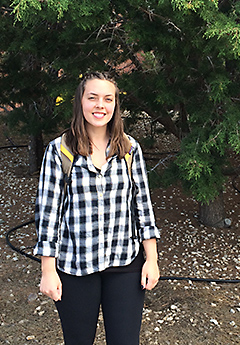
Rebekah Hollaway is receiving a $4,000 scholarship plus travel expenses as part of an Undergraduate Visualization and Modeling Network research grant funded by the National Science Foundation.
A new undergraduate research grant totaling $16,000 will allow an Environmental Science instructor and student assistant team to attend advanced training in watershed analysis research, and develop an educational module for Truckee Meadows Community College students.
Officially, the grant program is titled the Undergraduate Visualization and Modeling Network (UVMN) and is a part of a project funded by the National Science Foundation.
“The National Science Foundation grant is a prestigious award to have,” said Sameer Bhattarai, PhD, Environmental Science Instructor. “Professional development activities through this grant will allow us to be trained in watershed visualization and modeling and give us an opportunity to create a unique learning tool for TMCC students.”
Bhattarai and environmental science student, Rebekah Hollaway, teamed up to complete the extramural grant application, and found out in March that they have been given the award. It is open to undergraduate colleges conducting research in three states; Nevada, Idaho and New Mexico.
TMCC is the only community college in Nevada to receive this grant for the 2015-2016 academic year, Bhattarai said.
“We worked together to write the packet of materials,” Bhattarai said. “Rebekah wrote a nice statement about herself toward the grant – why she wanted to be a part of the program and what experiences she has to make this grant successful.”
Hollaway said that volunteer activities with local environmental organizations and her college major inspired her when helping to write the grant.
“I love animals and being outdoors,” she said. “I’ve been working as a veterinary assistant since high school and want to work with animals. I’m going to be graduating in 2017 with a Wildlife Ecology and Conservation degree, so anything related to environmental science will support my major studies.”
Instructor and Student Will Apply New Teaching Techniques to a Science Unit
Bhattarai and Hollaway will travel to Boise, Idaho on June 3-5 to learn teaching and research skills. They will also be trained in open source software that contributes to effective data visualization. Hollaway will receive a scholarship for $4000 plus travel expenses, and the balance of the award will go toward Dr. Bhattarai’s salary, his travel, and institutional costs.
“We will then study the watershed qualities in this region, what activities people participate in the area and how it affects the watershed here,” Bhattarai said.
Bhattarai said that he hopes next year’s students will notice the opportunities resulting from the successful National Science Foundation (NSF) award.
“Students could get encouraged to apply for the grant in future years,” he said. “Water quality is a growing field with jobs increasing.”
Careers related to water quality include:
- Environmental scientist
- Watershed scientist
- Natural resources manager
- Wildlife management specialist
Bhattarai and Hollaway will develop an educational module based on techniques learned at the summer conference and implement it during an environmental science class of Fall 2015 or Spring 2016. During the process, they will communicate with a mentor from the Western Consortium Watershed Analysis, Visualization, and Exploration (WC-WAVE) project that is funded by NSF.
CI Is Cyberinfrastructure-enabled Discovery and Innovation
The Undergraduate Visualization and Modeling Network (UVMN) has as its program goal to advance undergraduate research, watershed science and assist instructors and students to use Cyberinfrastructure (CI), or computer-enhanced data visualization. Geographic Information System (GIS) is a program utilized by many environmental scientists.
“Cyberinfrastructure is a term used to describe information technology systems that provide support for advanced data management and analysis,” Hollaway said. “GIS is one component – it is a tool that uses geographical data to look at watersheds. All of the water that falls on a specific area of land flows to a certain place. Using GIS, you can find where the water flows and collects in the watershed (based on the topography of the land).”
She said that GIS makes the information more interesting because it is displayed with graphics instead of purely text, and that information can easily be found about multiple factors affecting the watershed.
“It’s a lot easier than looking at many different maps for locations of roads, streams, fault lines, and more,” she said.
Bhattarai added that the visualization makes human impacts easier to see.
“In collaboration with the student team member, Ms. Hollaway, I will have the opportunity to use this knowledge to introduce my environmental science students to watershed modeling and visualization – a subject that is very relevant to understanding the impacts of human activities on natural resources including the water bodies of urban watershed, and the mitigating measures we can use to reduce such impacts,” Bhattarai said.
TMCC Students Will Contribute To Evaluating the Training Program’s Success
After completion of the program, the instructor and student assistant will write a report to submit back to NSF. Science students will contribute to the evaluation through online surveys, test results or discussion groups.
“Ms. Hollaway has stood out as a conscientious student, demonstrating exceptional work ethic and eagerness to do her very best,” Bhattarai said.
Hollaway says that it is about community, too.
“A big part of it for me was to meet other students who are involved in environmental science and get real experience in the career field I’d like to get into,” she said. “I’m looking forward to traveling and testing the water in different areas and to meeting other students and professionals.”
An Associate of Science, Environmental Science degree is offered at TMCC which may be transferred to the Bachelor of Science program at UNR. For more information about Environmental Science classes, contact the TMCC Physical Sciences Department at 775-673-7183.






